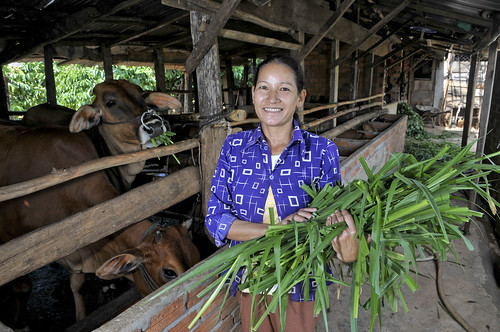A smallholder livestock farm in Dak Nong Province, Vietnam. Animals raised in mixed systems have a much lower water footprint on surface and groundwater bodies than those in industrialized farming systems (Photo credit: Neil Palmer/CIAT).
A leading researcher in water resources says that the efficiency of water use in smallholder livestock systems in Africa could be raised significantly through such means as reducing levels of concentrate feed used in livestock feeding systems, raising more livestock in drylands unsuitable for crop farming, and greater cooperation between livestock sector players and water management experts.
Arjen Hoekstra, a professor in water management from the University of Twente, in the Netherlands, made these remarks during a ‘Livestock live talk’ on ‘The water footprint of livestock products’ at the International Livestock Research Institute (ILRI) on 7 Feb 2013.
According to Hoekstra, every commodity has a water footprint –‘the volume of fresh water that is used to produce the commodity, summed over the various steps of the production chain’. This footprint includes when and where the water was used and the temporal and spatial dimensions of the water used.
About 4% of the global water footprint comes from domestic water use, but by far most of the world’s water footprint – 96% – is ‘invisible’ and is associated with agricultural and industrial products bought in markets.
‘Ninety-two per cent of humanity’s water footprint comes from agricultural production, and animal production is responsible for 29% of the water footprint of the global agricultural sector,’ said Hoekstra. Agriculture-related water use inefficiencies in developing countries contribute to a farming water footprint that is much larger in these countries than in developed countries.
Hoekstra presented results from a series of studies that looked at the globalization of water, the water footprint of animals and what can be done to reduce it. These studies focus on components of water consumption and water pollution in producing market commodities, including the volume of rain, surface or ground water evaporated or incorporated into a product and the volume of polluted water resulting from the processes of producing specific commodities.
His results show that in food production, animal products such as beef, poultry and pork had a consistently higher footprint than crops such as wheat and soybean.
‘The higher water footprint of animal products is mostly related to the origin and composition of animal feeds and the feed conversion efficiency’, said Hoekstra. ‘Whether concentrates are organic or conventional determines the pollution-related water footprint of the feed.’
Hoekstra noted that animals raised in grazing and mixed systems had a much lower water footprint on surface and groundwater bodies than those in industrialized farming systems. ‘Even though the conversion of feed to livestock product (milk or meat) improves as one moves from grazing to industrial systems, this is at the cost of more high-nutrient concentrate feed, which has a larger water footprint than roughages,’ he said.
Water footprint assessment is a growing field. ‘In future’, Hoekstra said, ‘stakeholders have the challenge of coming up with shared terminologies and calculations for a global water footprint standard and setting up benchmarks for quantitative water footprint reduction targets.’ A Water Footprint Network that brings together academia, governments and the private and public sectors has already been established towards this end.
View Arjen Hoekstra’s presentation:
Read a related article by Jane Gitau in ILRI’s People, Livestock and Environment blog.


I see. This is important to determine which areas of water have been used up regularly. Cattles need water everyday and so does other livestock.